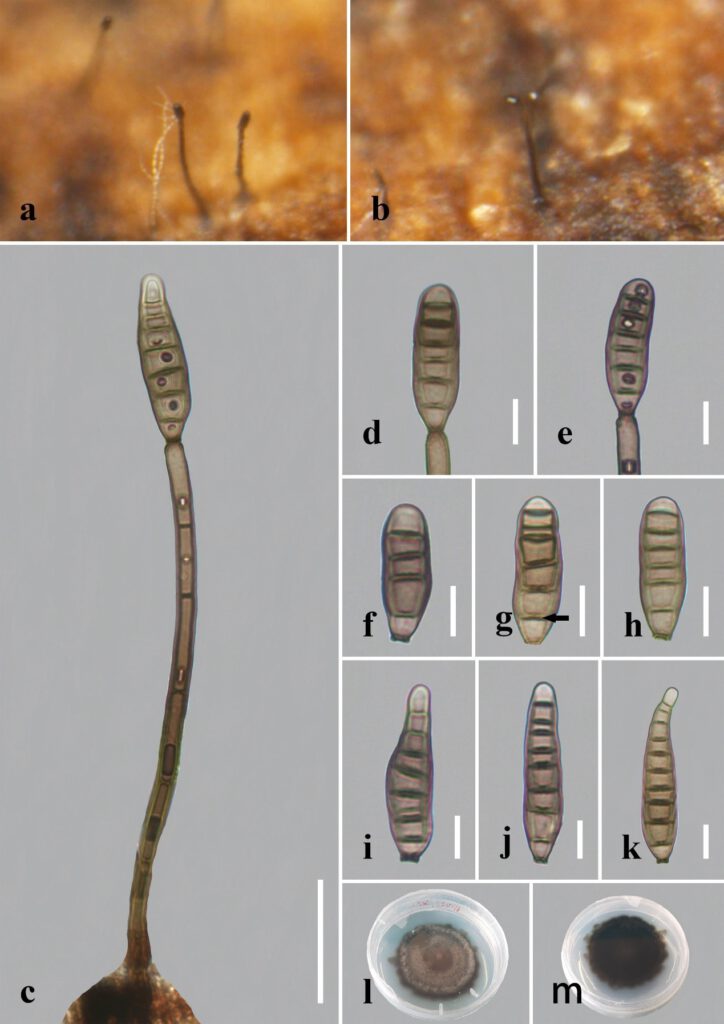Distoseptispora nonrostrata Y. Qing & H. Zhang, sp. nov.
MycoBank number: MB; Index Fungorum number: IF; Facesoffungi number: FoF 12580;
Description
Saprobic on decaying wood submerged in freshwater. Sexual morph: undetermined. Asexual morph: hyphomycetous. Colonies on the substratum superficial, effuse, hairy or velvety, dark-brown. Mycelium mostly immersed, consisting of branched, septate, smooth, subhyaline to pale-brown hyphae. Conidiophores 105–160 μm long (x̄=129 µm, n=10), 4.5–7 μm wide (x̄=5.5 µm, n=10), macronematous, mononematous, solitary, unbranched, 5–10-septate, cylindrical, straight or slightly flexuous, smooth, brown, becoming pale-brown towards apex. Conidiogenous cells 15–20 μm long (x̄=18 µm, n=10), 5–5.5 μm wide (x̄=5 µm, n=10), monoblastic, integrated, determinate, terminal, cylindrical, pale-brown, smooth. Conidia 22–51μm long (x̄=36 μm, n=20), 8–14 μm at the widest part (x̄=12 μm, n=20), 5.5–10 μm wide at the apex (x̄=8 μm, n=20), acrogenous, solitary, oblong, obclavate or narrowly obpyriform, mostly non-rostrate, rarely rostrate, straight or curved, 4–10-distoseptate, truncate at the base, smooth, thick-walled, pale-olivaceous or pale-brown.
Material examined: China, Sichuan Province, Yibin City, Southern Sichuan Bamboo Sea, Qicai Lake, found on dead, submerged, decaying bamboo, 13 November 2020, Yun Qing, SN–16 (HKAS 122185, holotype), ex-type living culture KUNCC 21–10730.
Distribution: (China)
Sequence data: ITS: OK310699 (ITS5/ITS4); LSU: OK341198 (LROR/LR5); TEF1a: OP413481 (983/2218R); RPB2: OP413475 (fRPB2-5F/fRPB2-7cR)
Notes: In phylogenetic analyses, Distoseptispora nonrostrata cluster with D. effusa. Morphologically, D. nonrostrata possesses oblong, obclavate or narrowly obpyriform, mostly non-rostrate, pale-olivaceous or pale-brown conidia, while D. effusa is clearly different in having obclavate, rostrate, olivaceous-brown to dark-brown, longer conidia (35.5–113 μm vs. 22–51 μm). Comparisons of sequence data between these two species showed differences of 27 (4.9%, four gaps) and 34 (3.8%, no gaps) noticeable nucleotides in ITS and TEF gene regions, respectively. Therefore, we introduce D. nonrostrata as a new species.

Fig. x. Distoseptispora nonrostrata (holotype). (a,b) Colonies on natural substrate. (c) Conidiophore with conidium. (d,e) Conidiogenous cells bearing conidia. (f–k) Conidia. The arrow in g points to a gap in the middle of the septum, which indicates the distosepta. (l) Colony on PDA (from front). (m) Colony on PDA (from reverse). Scale bars: (c) 30 μm; (d–k) 10 μm.
